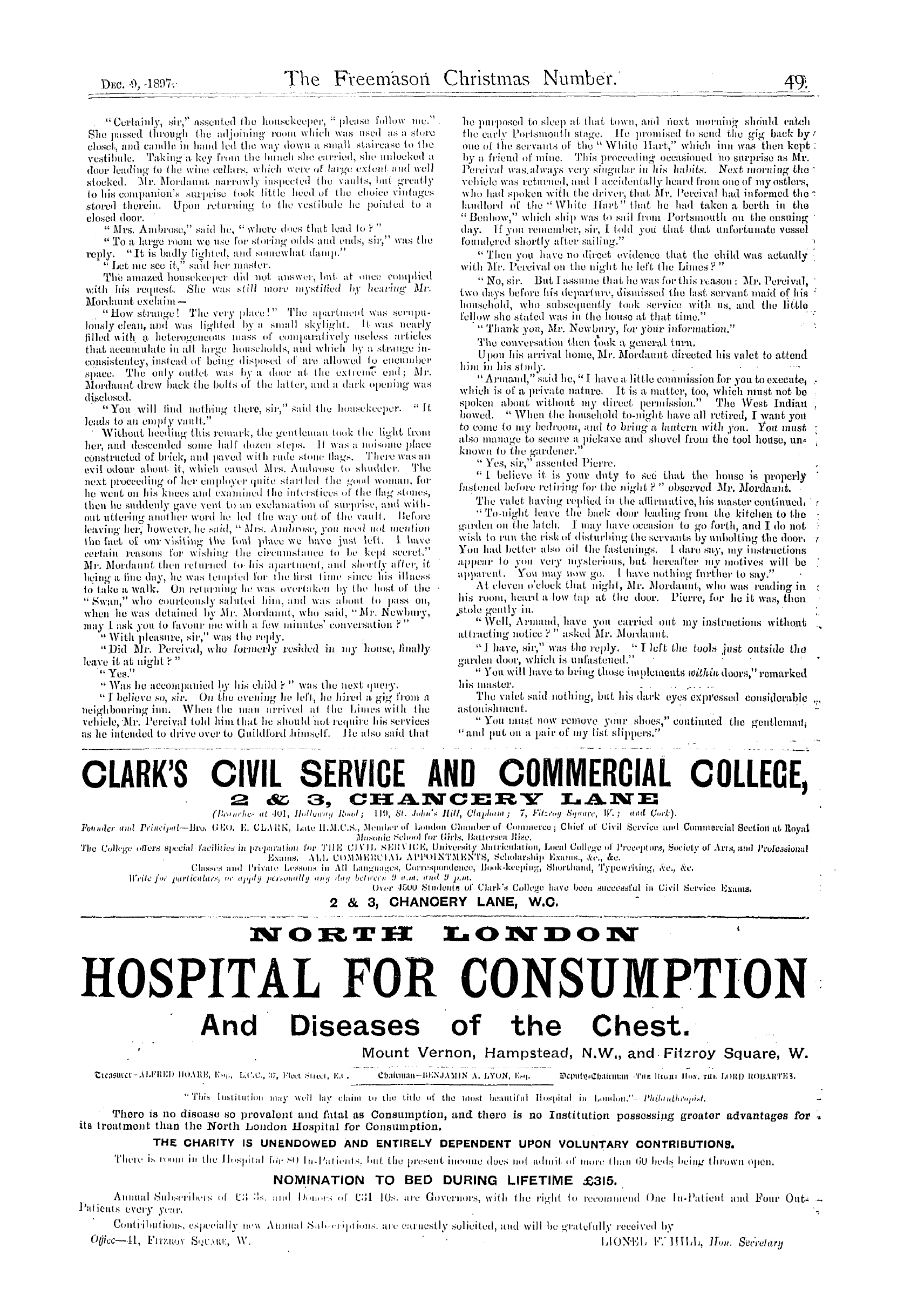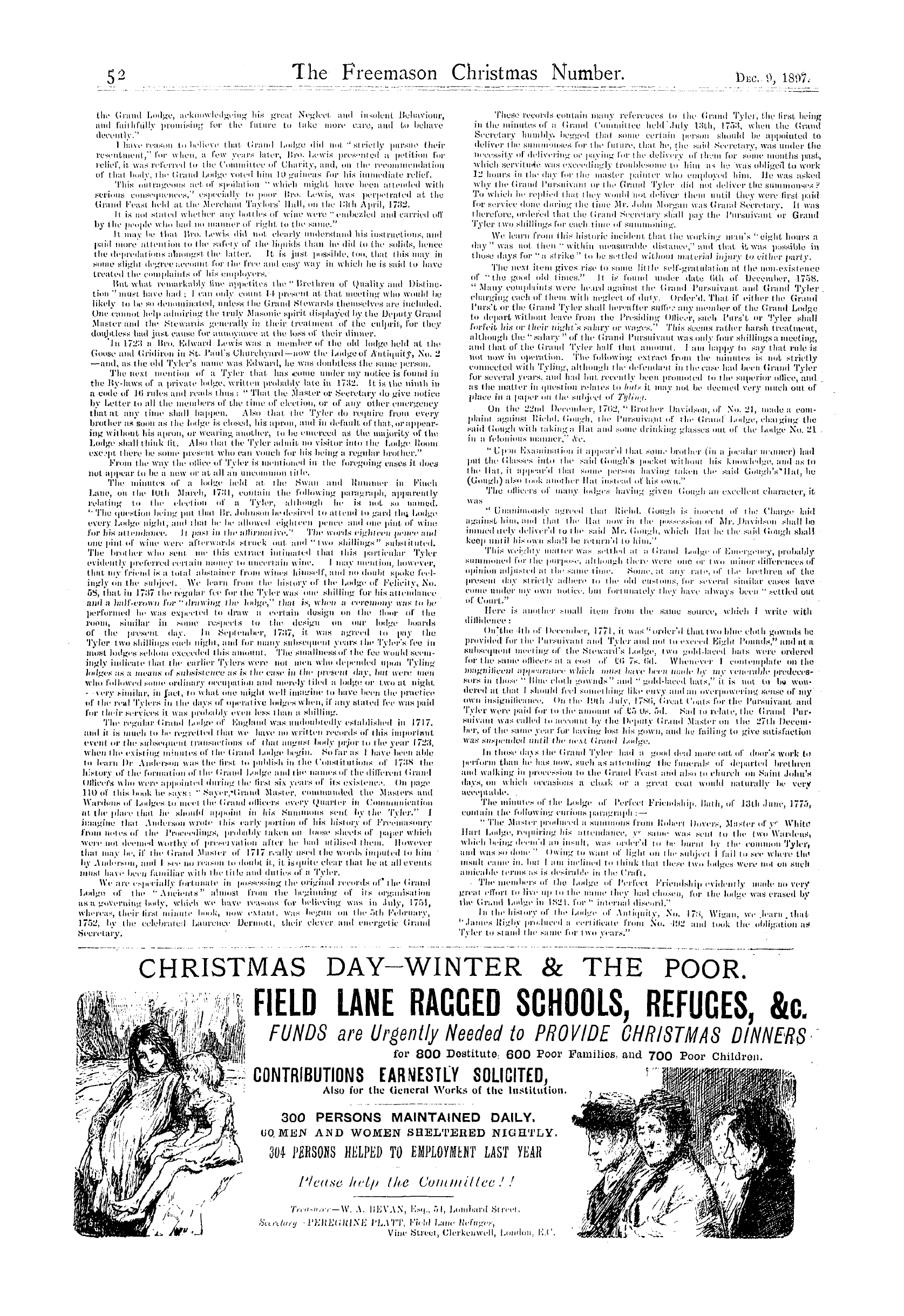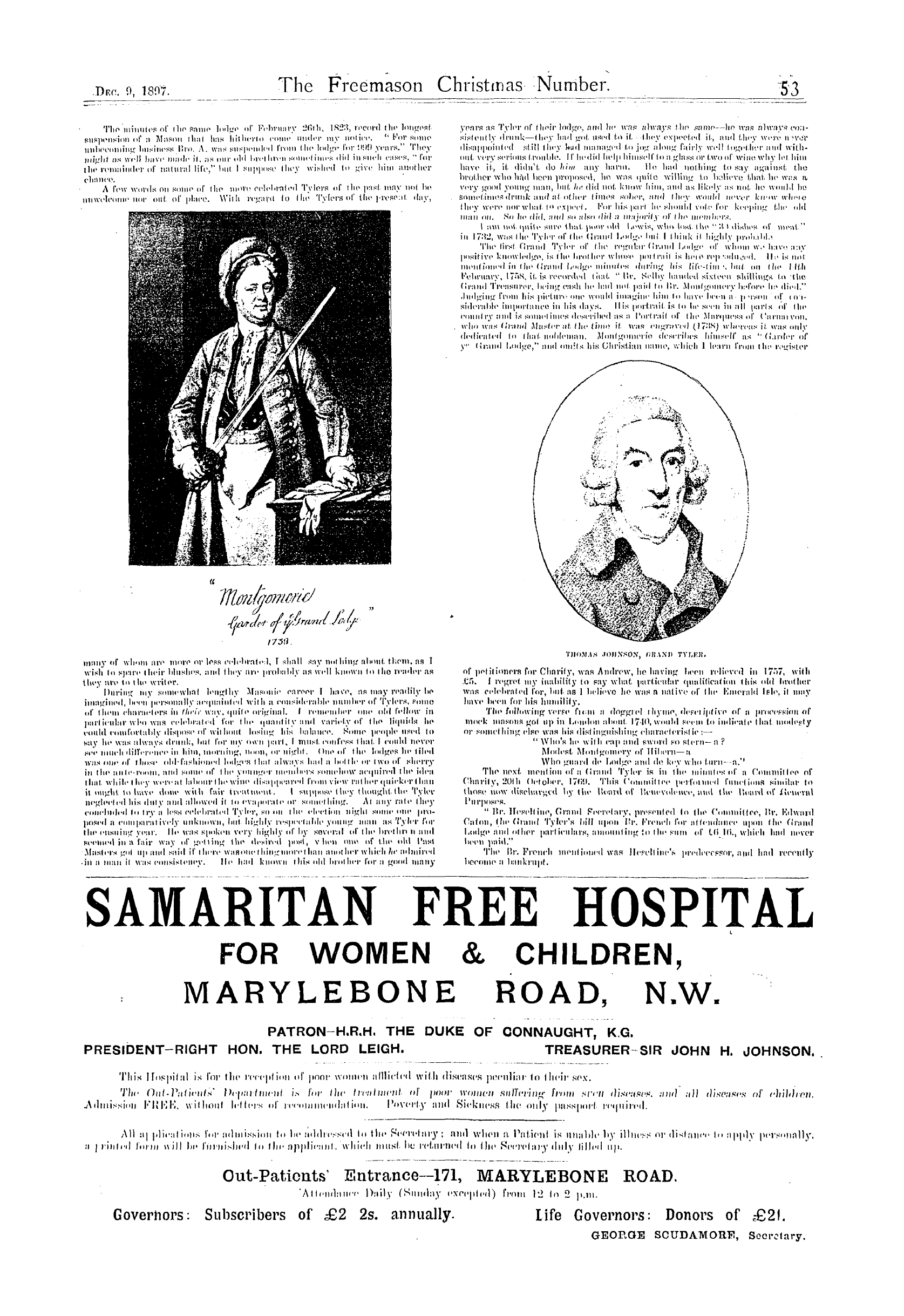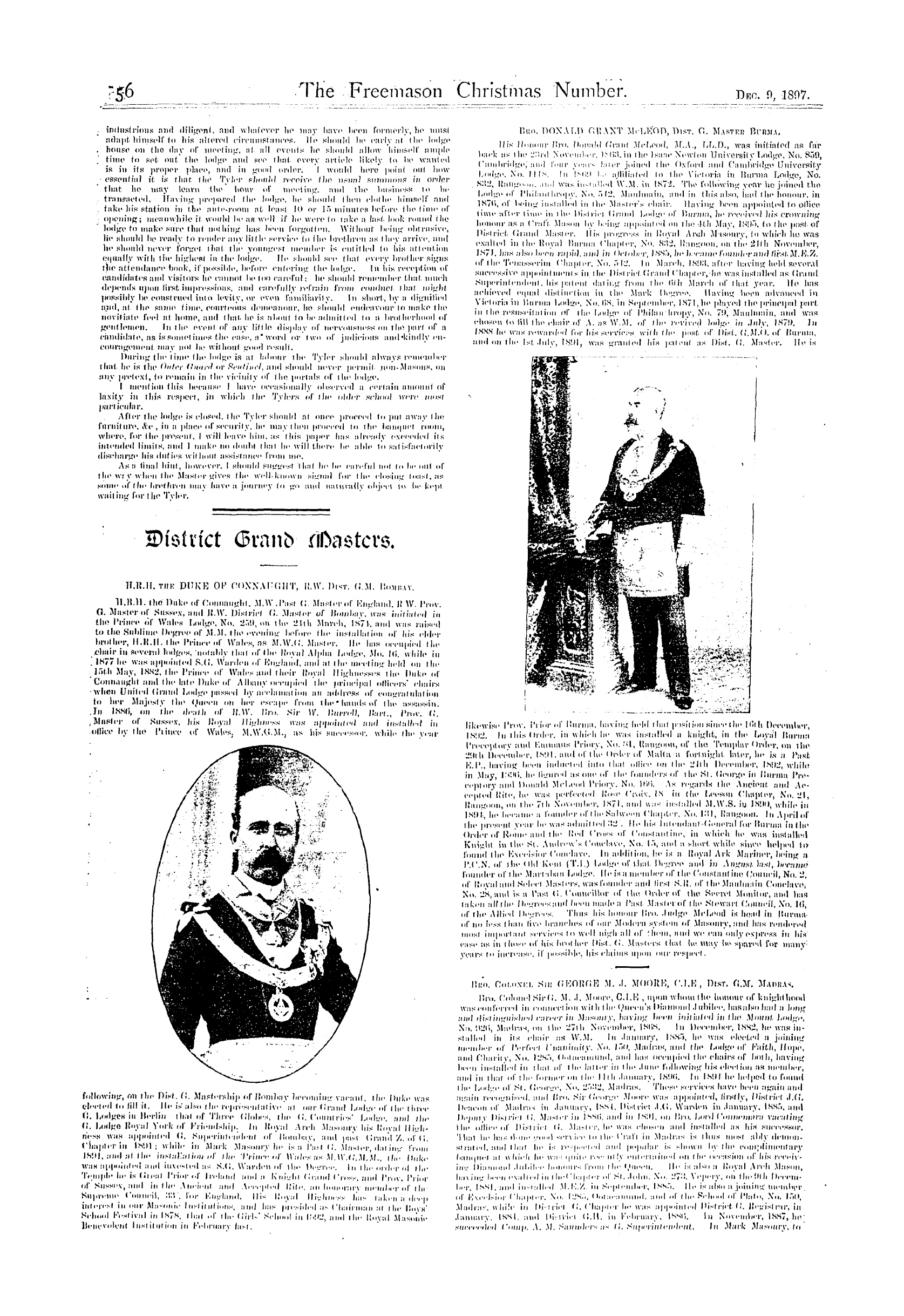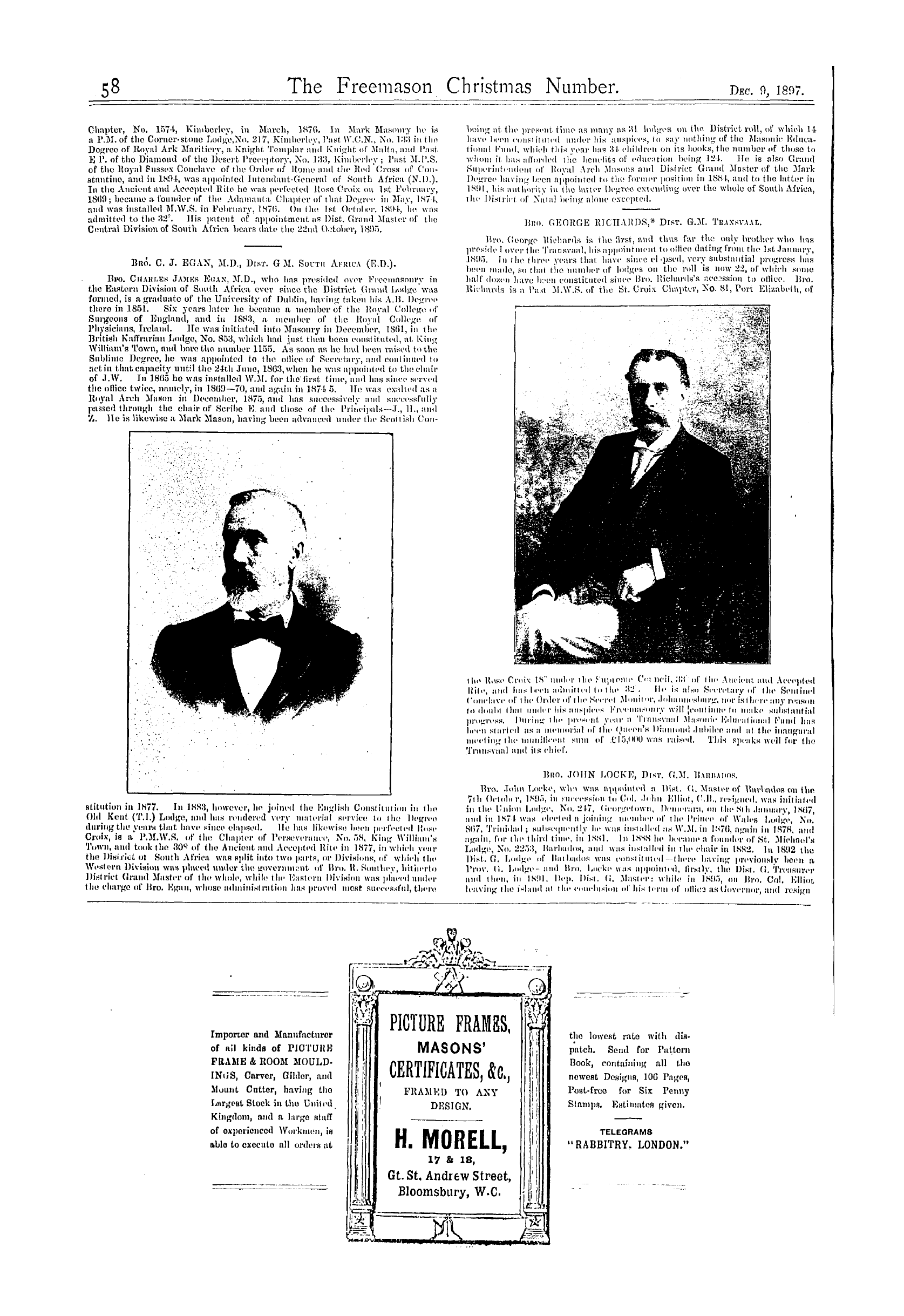-
Articles/Ads
Article Quatuor Coronati Lodge, No. 2076. ← Page 4 of 5 →
Note: This text has been automatically extracted via Optical Character Recognition (OCR) software.
Quatuor Coronati Lodge, No. 2076.
of the landscape would be gone , and our dearest friends would pass us unheeded and unseen , and everyday life would resolve itself into a task similar to that of attempting to read our newspaper every morning by means of a powerful microscope , we should commence by getting on to a big black blotch , and after
wandering about that for half an hour , we mi-jht then begin to find out lhat we were looking at the little letter e , but anything like reading would be quite out of the question . Wc may therefore be thankful that our eyes have the imperfection of not appreciating parallel rays . But we will now consider how this
imperfection may be remedied by science . There are two ways of doing this—viz ., firstly , by increasing the amount of light received by means of telescopes of great aperture ; and , secondly , by employing an artificial retina a thousand times more sensitive than the human . Now , the human retina receives the impression
of what it looks at in a fraction of a second , provided , of course , that the eye is properly focussed , and no further impression will be made by keeping the eye fixed on that object ; but in celestial p hotography , when the telescope is turned into a camera , the sensi ' ive plate , having received the impression in the first second ,
may be exposed not only for many seconds or minutes or hours , but for an aggregate of even days by re-exposure , every second of which time details on that plate new objects sunk so deep in the vast depths of space as to be immeasurably beyond the power of the human eye , even through telescopes hundreds of times
more powerful than the largest instruments that science has enabled us to construct , and yet here is laid before us a faithful chart , by means of which we may once more continue ourjourney through space . A short exposure will show us firmaments and nebuke just outside the range of our greatest telescopes , and
every additional second extends our vision by such vast increases of distance that thc brain reels at the thought ; and yet , as we have seen , exposures of these sensitive plates may be made not only for seconds , but for thousands and even hundreds of thousands of seconds ! And vet there is no end , no end where
the weary mind can rest and contemplate ; the soul of man can only cry out that there is no limit . In spite of all its strivings and groping by aid of speculative philosophy , the finite mind of man cannot attain to infinity , or get any nearer to where the mighty sea of time breaks in noiseless waves on the dim shores of eternity .
Let us now examine in a similar manner the second great mystery , the Infinity of Time . With this object in view we will lirst consider the human sense of sight and hearing . We will once more start at the beginning and take sound , or the vibrations which affect thc drum of the human ear . Now
sound travels in air at about 1 , 130 feet per second , and if the vibrating body oscillates sixteen times in one second , it follows lhat , spread over this 1 , 130 feet , there will be 16 waves , giving a length of about 70 feet to each wave . This is tlie lowest sound lhat the human ear can appreciate as a musical note .
When the number of vibrations m a second sinks below 16 , the ear no more appreciates them as a musical sound , but hears them in separate vibrations of beats . The best instrument for illustrating this is the " Singing Syren . " This comprises a tin drum with 16 holes pierced at regular intervals round the top ;
underneath this top a jet of high pressure steam or air forces itself through each of the holes successively as the drum revolves . When the drum does not quite complete one revolution is a second , only 15 puffs come to the ear in a second of time , and they are heard as puffs ; but when the rate reaches one revolution
111 a second , the sound , as if by magic , changes into the lowest musical sound . Ihe octave above this is obtained by doubling the number of puffs , namely , by revolving the drum twice in one second , and the next octave by revolving four times in a second , and so on , until at about the 13 th octave the sound has become
so high that the majority 01 listeners cannot hear it , and fancy it must have stopped , whereas a few will still be saying " How shrill it is . " At last , at about the 14 th octave , the vibrations have passed beyond the range of the human ear , though we have every reason to believe that many insects can hear far higher
sounds . We have now only to traverse about forty octaves before we arrive at those subtle vibrations which the eye appreciates as light . Beginning with red , the effect transmitted to the brain passes to orange , yellow , green , blue , indigo , and violet ; only about one octave that the eye can appreciate , and
all is darkness ; but we can still go on a little further by the help of science . Beyond the violet we have the actinic or chemical rays , which are used in photography , and which enable us to Irace the vibrations for a further half octave . Beyond this we
cannot pierce with our present knowledge ; but there maybe , and probably are , latent in our nature , senses which , properly developed , will be able lo appreciate still more subtle vibrations and organs which perhaps even now are being prepared ( or the reception of these subtle influences . Science steadily points to
electricity and magnetism being a form of motion , and it may be that in these invisible rays we may some day discover the nature of those mysterious forces . We want , as it were , a special " microscope" to examine these vibrations , and a similar method to that already mentioned on Space under Celestial Photography , to enable us to traverse and examine hundreds or thousands of
octaves by each second of exposure ; * for although the path extends to infinity , we have already arrived at the utmost limits of our finite senses , and lind that after all we can only appreciate , as it were , a few inches along the huge line of infinite extent , stretching from the Creator , the Infinite , down to the Created or
Finite ; and bear in mind that we have only travelled in one direction ; the path we have taken extends in the opposite direction also to Infinity . We started with 16 vibrations in a second , as the lowest number we human beings can appreciate as a musical sound ; let us now descend by octaves . The octave
below is 8 vibrations in a second ; the next , four ; then two ;' and then one vibration in a second . But we do not stop there . The octave below this is one vibration in two seconds , then in four seconds , eight seconds , sixteen seconds , and so on , until even
the pulsation of one vibration in a million years would be appreciated as a musical sound , or even as one of the colours of the spectrum , by a Being whose senses were infinite , and to whom the lapse of ages , therefore , had no objective reality .
Bro . Klein at thisstatje presented a curious piece of mechanism , which he had specially devised to illustrate this part of his subject , and wilh the assistance of Dr . Wynn Westcott , who had t'cen
placed by him in the Senior Deacon ' s chair for that piwpose , he exhibited to the Brethren ' present a piece of " pure Mediatval Magic , " the Lodge being filled with strange musical harmonies of great beauty , loilhout the aid of any known musical instrument .
Once more we must call a halt . Our finite minds become bewildered in attempting to even glance at these infinities of Time . Let us change our view , and examine this subject under a different aspect . We measure Space by miles , yards , feet and inches , and we
measure lime by years , hours , minutes , seconds , and by these finite means we try to fathom these two marvellous infinities . With our greatest efforts of thought we find , however , that we can get relatively no distance whatever from the here of Space
and the now of Time . It is true that the " present , " as a mathematical point , appears to be hurrying and bearing us with it along the line stretching from past to future eternity , but in reality we arc no further from the one or nearer to the other , Now let us start again from the beginning .
hirst of all , look round this Lodge and note the different objects to be seen . Even in so small a room you do not ' see the objects as they really are at this instant , but as they were at a certain fixed length of time ago . Those objects which are further away are further behind in point of time than those lhat
are nearer to you—in fact , however near you are to an object , you can never see it as it is , but only as it was . We are dealing with very minute differences here , they being based on the rate at which Light travels ; but they are differences which are known with a wonderful degree of accuracy , and I will now explain shortly how the rate at which light travels was lirst discovered .
In thc year 16 75 , the orbit of one of the moons of Jupiter had been calculated , and a table drawn up showing the times at which the eclipses , or times of disappearance of the moon behind the body of Jupiter should take place , it was , however , found by observations that there were great discrepancies in
these tables . The eclipse always took place before the calculated time when Jupiter was nearest to the earth and after the calculated time when Jupiter was furthest from the earth . The regularity of these discrepancies suggested thai they were connected in some way with the variation of distance from the
earth ; and b y a happy inspiration Romer conjectured and proved that the true cause was that light is not , as was before that time taken for granted , propagated instantaneousl y through space , but travels at the rate of about 186 , 000 miles per second .
Now let us follow our subject . The moon is 240 , 000 miles distant . We do not , therefore , ever see her as she is , but as she was one and a quarter seconds ago . In the same way wc see the sun as he was eight minutes ago , and we sec Jupiter as he was nearly an hour ago . Let us go further to one of the nearest
fixed stars . We see the star as it was more than 10 years agothat slar may , therefore , have exploded or disappeared 10 long years ago , and yet we still see it shining , and shall continue to see il until the long line of light has run itself out ; all round us
in fact , are the appearances of blazing suns as they were thousands of years ago , and by the aid of the telescope and of our sensitive plate , we catch the light which started from clusters and firmaments probably millions of years ago . Now let us take
Note: This text has been automatically extracted via Optical Character Recognition (OCR) software.
Quatuor Coronati Lodge, No. 2076.
of the landscape would be gone , and our dearest friends would pass us unheeded and unseen , and everyday life would resolve itself into a task similar to that of attempting to read our newspaper every morning by means of a powerful microscope , we should commence by getting on to a big black blotch , and after
wandering about that for half an hour , we mi-jht then begin to find out lhat we were looking at the little letter e , but anything like reading would be quite out of the question . Wc may therefore be thankful that our eyes have the imperfection of not appreciating parallel rays . But we will now consider how this
imperfection may be remedied by science . There are two ways of doing this—viz ., firstly , by increasing the amount of light received by means of telescopes of great aperture ; and , secondly , by employing an artificial retina a thousand times more sensitive than the human . Now , the human retina receives the impression
of what it looks at in a fraction of a second , provided , of course , that the eye is properly focussed , and no further impression will be made by keeping the eye fixed on that object ; but in celestial p hotography , when the telescope is turned into a camera , the sensi ' ive plate , having received the impression in the first second ,
may be exposed not only for many seconds or minutes or hours , but for an aggregate of even days by re-exposure , every second of which time details on that plate new objects sunk so deep in the vast depths of space as to be immeasurably beyond the power of the human eye , even through telescopes hundreds of times
more powerful than the largest instruments that science has enabled us to construct , and yet here is laid before us a faithful chart , by means of which we may once more continue ourjourney through space . A short exposure will show us firmaments and nebuke just outside the range of our greatest telescopes , and
every additional second extends our vision by such vast increases of distance that thc brain reels at the thought ; and yet , as we have seen , exposures of these sensitive plates may be made not only for seconds , but for thousands and even hundreds of thousands of seconds ! And vet there is no end , no end where
the weary mind can rest and contemplate ; the soul of man can only cry out that there is no limit . In spite of all its strivings and groping by aid of speculative philosophy , the finite mind of man cannot attain to infinity , or get any nearer to where the mighty sea of time breaks in noiseless waves on the dim shores of eternity .
Let us now examine in a similar manner the second great mystery , the Infinity of Time . With this object in view we will lirst consider the human sense of sight and hearing . We will once more start at the beginning and take sound , or the vibrations which affect thc drum of the human ear . Now
sound travels in air at about 1 , 130 feet per second , and if the vibrating body oscillates sixteen times in one second , it follows lhat , spread over this 1 , 130 feet , there will be 16 waves , giving a length of about 70 feet to each wave . This is tlie lowest sound lhat the human ear can appreciate as a musical note .
When the number of vibrations m a second sinks below 16 , the ear no more appreciates them as a musical sound , but hears them in separate vibrations of beats . The best instrument for illustrating this is the " Singing Syren . " This comprises a tin drum with 16 holes pierced at regular intervals round the top ;
underneath this top a jet of high pressure steam or air forces itself through each of the holes successively as the drum revolves . When the drum does not quite complete one revolution is a second , only 15 puffs come to the ear in a second of time , and they are heard as puffs ; but when the rate reaches one revolution
111 a second , the sound , as if by magic , changes into the lowest musical sound . Ihe octave above this is obtained by doubling the number of puffs , namely , by revolving the drum twice in one second , and the next octave by revolving four times in a second , and so on , until at about the 13 th octave the sound has become
so high that the majority 01 listeners cannot hear it , and fancy it must have stopped , whereas a few will still be saying " How shrill it is . " At last , at about the 14 th octave , the vibrations have passed beyond the range of the human ear , though we have every reason to believe that many insects can hear far higher
sounds . We have now only to traverse about forty octaves before we arrive at those subtle vibrations which the eye appreciates as light . Beginning with red , the effect transmitted to the brain passes to orange , yellow , green , blue , indigo , and violet ; only about one octave that the eye can appreciate , and
all is darkness ; but we can still go on a little further by the help of science . Beyond the violet we have the actinic or chemical rays , which are used in photography , and which enable us to Irace the vibrations for a further half octave . Beyond this we
cannot pierce with our present knowledge ; but there maybe , and probably are , latent in our nature , senses which , properly developed , will be able lo appreciate still more subtle vibrations and organs which perhaps even now are being prepared ( or the reception of these subtle influences . Science steadily points to
electricity and magnetism being a form of motion , and it may be that in these invisible rays we may some day discover the nature of those mysterious forces . We want , as it were , a special " microscope" to examine these vibrations , and a similar method to that already mentioned on Space under Celestial Photography , to enable us to traverse and examine hundreds or thousands of
octaves by each second of exposure ; * for although the path extends to infinity , we have already arrived at the utmost limits of our finite senses , and lind that after all we can only appreciate , as it were , a few inches along the huge line of infinite extent , stretching from the Creator , the Infinite , down to the Created or
Finite ; and bear in mind that we have only travelled in one direction ; the path we have taken extends in the opposite direction also to Infinity . We started with 16 vibrations in a second , as the lowest number we human beings can appreciate as a musical sound ; let us now descend by octaves . The octave
below is 8 vibrations in a second ; the next , four ; then two ;' and then one vibration in a second . But we do not stop there . The octave below this is one vibration in two seconds , then in four seconds , eight seconds , sixteen seconds , and so on , until even
the pulsation of one vibration in a million years would be appreciated as a musical sound , or even as one of the colours of the spectrum , by a Being whose senses were infinite , and to whom the lapse of ages , therefore , had no objective reality .
Bro . Klein at thisstatje presented a curious piece of mechanism , which he had specially devised to illustrate this part of his subject , and wilh the assistance of Dr . Wynn Westcott , who had t'cen
placed by him in the Senior Deacon ' s chair for that piwpose , he exhibited to the Brethren ' present a piece of " pure Mediatval Magic , " the Lodge being filled with strange musical harmonies of great beauty , loilhout the aid of any known musical instrument .
Once more we must call a halt . Our finite minds become bewildered in attempting to even glance at these infinities of Time . Let us change our view , and examine this subject under a different aspect . We measure Space by miles , yards , feet and inches , and we
measure lime by years , hours , minutes , seconds , and by these finite means we try to fathom these two marvellous infinities . With our greatest efforts of thought we find , however , that we can get relatively no distance whatever from the here of Space
and the now of Time . It is true that the " present , " as a mathematical point , appears to be hurrying and bearing us with it along the line stretching from past to future eternity , but in reality we arc no further from the one or nearer to the other , Now let us start again from the beginning .
hirst of all , look round this Lodge and note the different objects to be seen . Even in so small a room you do not ' see the objects as they really are at this instant , but as they were at a certain fixed length of time ago . Those objects which are further away are further behind in point of time than those lhat
are nearer to you—in fact , however near you are to an object , you can never see it as it is , but only as it was . We are dealing with very minute differences here , they being based on the rate at which Light travels ; but they are differences which are known with a wonderful degree of accuracy , and I will now explain shortly how the rate at which light travels was lirst discovered .
In thc year 16 75 , the orbit of one of the moons of Jupiter had been calculated , and a table drawn up showing the times at which the eclipses , or times of disappearance of the moon behind the body of Jupiter should take place , it was , however , found by observations that there were great discrepancies in
these tables . The eclipse always took place before the calculated time when Jupiter was nearest to the earth and after the calculated time when Jupiter was furthest from the earth . The regularity of these discrepancies suggested thai they were connected in some way with the variation of distance from the
earth ; and b y a happy inspiration Romer conjectured and proved that the true cause was that light is not , as was before that time taken for granted , propagated instantaneousl y through space , but travels at the rate of about 186 , 000 miles per second .
Now let us follow our subject . The moon is 240 , 000 miles distant . We do not , therefore , ever see her as she is , but as she was one and a quarter seconds ago . In the same way wc see the sun as he was eight minutes ago , and we sec Jupiter as he was nearly an hour ago . Let us go further to one of the nearest
fixed stars . We see the star as it was more than 10 years agothat slar may , therefore , have exploded or disappeared 10 long years ago , and yet we still see it shining , and shall continue to see il until the long line of light has run itself out ; all round us
in fact , are the appearances of blazing suns as they were thousands of years ago , and by the aid of the telescope and of our sensitive plate , we catch the light which started from clusters and firmaments probably millions of years ago . Now let us take















































